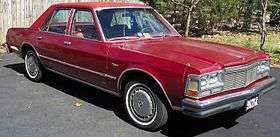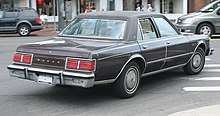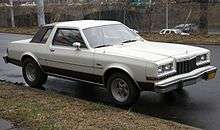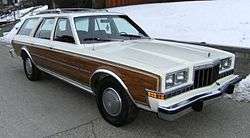Dodge Diplomat
The Dodge Diplomat is an American mid-size car that was produced by Dodge from 1977 to 1989. It was built using the same design as the Plymouth Gran Fury in the U.S. market and the Plymouth Caravelle in Canada. It was also sold in Mexico between 1981 and 1982 as the Dodge Dart, and in Colombia as the Dodge Coronet. The Diplomat was initially offered in a coupe and a sedan. In 1978, station wagons were added as replacements for the discontinued full-sized C-body wagons.
| Dodge Diplomat | |
|---|---|
 1977 Dodge Diplomat four-door | |
| Overview | |
| Manufacturer | Chrysler Corporation |
| Also called |
|
| Production | 1977–December 1988 |
| Model years | 1977–1989 |
| Assembly | St. Louis, Missouri, United States Kenosha, Wisconsin, United States Newark, Delaware, United States Windsor, Ontario, Canada Bogotá, Colombia |
| Body and chassis | |
| Class | Mid-size car |
| Body style |
|
| Layout | FR layout |
| Platform | M-body |
| Related | |
| Powertrain | |
| Engine | 225 cu in (3.7 L) Slant 6 I6 318 cu in (5.2 L) LA V8 360 cu in (5.9 L) LA V8 (1978-1979) |
| Transmission | 4-speed A833 manual 3-speed A727 automatic 3-speed A904 automatic 3-speed A999 automatic |
| Dimensions | |
| Wheelbase | Coupe: 112.7 in (2,863 mm) 1977–1979, 108.7 in (2,761 mm) 1980–1981, Sedan & wagon: 112.7 in (2,863 mm) 1977–1989 (wagons through 1981 only) |
| Length | Coupe, 1977-1979: 204.1 in (5,184 mm) 1980-1981: 201.2 in (5,110 mm) 1977–83 Sedan: 206.1 in (5,235 mm) 1987–89 Sedan: 204.6 in (5,197 mm) Wagon: 205.5 in (5,220 mm) |
| Width | Coupe & wagon: 74.2 in (1,885 mm) 1980–83 Sedan: 72.8 in (1,849 mm) 1987–89: 72.4 in (1,839 mm) |
| Height | Coupe: 53.4 in (1,356 mm) Wagon: 55.5 in (1,410 mm) Sedan: 55.1 in (1,400 mm) |
| Chronology | |
| Predecessor | Dodge Dart |
| Successor | Dodge Monaco |
The Diplomat was offered with a 225 cu in (3.7 L) straight-6 engine a well as optional 318 cu in (5.2 L) and 360 cu in (5.9 L) V8s. The Diplomat, along with its Plymouth Gran Fury/Caravelle twin, were popular police cars both in the US and Canada. The three-speed Torqueflite automatic transmission was most popular, but a manual transmission was available until 1981 only on six cylinder and 318 V8 models.
Background
The Diplomat name was originally used by Dodge on 2-door hardtop models from 1950 to 1954. It was also used on the export version of the DeSoto from 1946 through 1961. In 1975–77, the Diplomat name was also used on a trim package available on the Royal Monaco two-door hardtop. Starting with the 1977 model year, the Diplomat became a full model line, rather than as the name of a particular body style.
First generation (1977)

Introduced as a late 1977 model during spring 1977, the first generation Diplomats were a longer, fancier upmarket version of the F-body Aspen. The chassis and mechanical components are similar with doors and various other body panels interchangeable with the Aspens. Unique to the Diplomat were the front and rear header panels, bumpers, hood and trunk lid. Larger taillights extended into the rear hatch of the station wagon. The station wagons were shorter than the sedans and coupes, which had unique bodywork with a longer rear overhang. The station wagon, introduced for the 1978 model year, used the same rear sheetmetal as the Aspen/Volaré, albeit with its own wraparound taillights.
.jpg)
The first year models were available in base and Medallion trim levels; the base engine was the 318 Lean Burn V8 developing 145 hp (108 kW) and the 110 hp (82 kW) Slant Six was a credit option.[1] A vinyl roof was standard on sedans, while a simulated landau roof cover was an option on coupes. For 1978 the Slant Six with a four-speed manual transmission became the base drivetrain, and the station wagon was added. The wagon featured "teakwood"-grain body appliques (a delete option) and was only available in base trim. The sedans and coupes continued largely unchanged, but a low-cost "Diplomat S" was added. This model was offered for one year, and the 3,322 produced represented only about 5% of overall Diplomat production in 1978.[2] The V8's output dropped by five horsepower, but on the other hand, a 155 hp (116 kW) 360 cu in (5.9 L) V8 became a new option.[2]
For the 1979 model year, the Diplomat received a minor facelift. The grille was now divided into three rows of eight rectangular openings with an internal crosshatch pattern and a broad band on top. The sedan and coupe taillights were also altered, now with a horizontal theme while divided down the middle. The lineup was rearranged, with the base model decontented and a Salon model (corresponding to last year's base version) fitting in the middle below the Medallion.[3] The new base model did not receive the padded vinyl roof (sedans). Coupes had a new landau top design, with much smaller rear side windows. The station wagon came in Salon trim, without any actual changes in equipment. The Slant Six, meanwhile, was available with a single-barrel carburetor and 100 hp (75 kW). V8 outputs dropped by five horsepower, to 135 and 150 hp (101 and 112 kW) respectively, but optional was a four-barrel 360 producing 195 hp (145 kW).[3] This was the last year for the 360 engine in the Diplomat.
Second generation (1980)
The 1980 model year brought new exterior sheet metal for the Diplomat, although wagons were unchanged, from the doors back. While the previous coupes used the same 112.7 inch wheelbase as the other models, the 1980 coupe used the 108 inch wheelbase of the Aspen coupe (though the square body was very different). The front end was more evolutionary than revolutionary, but in order to share a hood with the newly restyled Chrysler LeBaron the grille was narrowed considerably, with an arguably unfortunate effect on appearance and sales. The roofline of the sedan was also made more square, marginally improving headroom, and conservative, Buick-like taillights appeared on all but the wagons. Manual transmissions were dropped. Following the demise of the Dodge St. Regis R-body in 1981, the Diplomat remained, becoming the largest sedan in the Dodge lineup, despite technically being a mid-size car. Dodge would not market another truly full-size car (at least based upon United States Environmental Protection Agency (EPA) passenger volume statistics) until the Monaco debuted as a 1990 model.
By 1981, Chrysler was switching to smaller front-wheel drive designs. However, its older and larger rear-wheel drive Dodge Diplomat (as well as the Chrysler LeBaron and Fifth Avenue) continued to sell. Chrysler's then executive vice president for manufacturing, Steve Sharf, met with officials at American Motors (AMC) to use the extra capacity at an assembly plant in Kenosha, Wisconsin to build the cars.[4] Chrysler's tooling was moved from St. Louis to Kenosha, and from 1987 until 1989 about 250,000 Chrysler and Dodge models were built by AMC at a lower cost than Chrysler could.[4] This relationship evolved into Chrysler's purchase of AMC in 1987.[4]

In 1982, the coupe and station wagon were discontinued and Canada's Plymouth version of the Diplomat came south of the border. The Plymouth Caravelle was offered in the United States as the Plymouth Gran Fury. 1983 was the last year for the Slant Six, and afterwards, the only available engine was the 318-cid V8 with a two-barrel carburetor. A four-barrel 318 remained the optional engine choice for the police package. For 1984, the appearance of the upscale Special Edition or SE used the Fifth Avenue's front end with its parking lights located above the headlights, and a bright metal cross overlaid on the Chrysler grille's thin vertical bars. The SE had more exterior trim and an interior that placed the SE between the Diplomat Salon and the Chrysler Fifth Avenue.
As the 1980s progressed, fewer private customers purchased the Diplomat, and the M-body was eventually dropped during the 1989 model year. Sales of cars equipped with the Police Package represented about half of the Diplomat production after the discontinuation of the coupe and station wagons.[5] Late in the Diplomat's run, the car was subject to the federal "Gas Guzzler Tax" and required premium unleaded gasoline. Although sales were strong, Chrysler CEO Lee Iacocca held a low opinion of the M-body line as a relic of the pre-K car era and declined to invest any money in them. Despite lower gas prices in the mid- to late-1980s and a 2.26:1 rear-end gear ratio, the Diplomat's carbureted engine and lack of an overdrive gear on its TorqueFlite automatic transmission resulted in poor fuel economy compared with its larger competitors from Ford and General Motors, as evidenced by comparing the EPA estimates for 1986 models:
- Dodge Diplomat (5.2 L V8, 3-speed automatic): 16 city, 21 highway, 18 combined
- Chevrolet Caprice (5.0 L V8, 4-speed automatic with overdrive): 17 city, 25 highway, 20 combined
- Ford LTD Crown Victoria (5.0 L V8, 4-speed automatic with overdrive): 18 city, 26 highway, 21 combined
 1980 Station wagon |
However, Diplomats built from mid-1988 until the end of production were among the first Chrysler-built products to have a driver's side airbag as standard equipment, some two model years before the remainder of Chrysler's lineup and they were also among the only cars at the time to offer a tilt steering column with an airbag. Diplomats with airbags differed from earlier models in that they were also equipped with a padded, color-keyed knee blocker which extended out from beneath the instrument panel in front of the driver.
Discontinuation
When the Diplomat and similar Plymouth Gran Fury were discontinued, it marked the last rear-wheel drive non-truck model (aside from the Dodge Viper) sold by the corporation until the Plymouth Prowler was introduced in 1997. The Diplomat's other rear-wheel drive sibling, the Chrysler Fifth Avenue, also ended production, but the nameplate was continued on a front-wheel drive chassis. In the Dodge lineup, the Monaco became the top-of-the-line sedan until the introduction of the LH platform.
References
- Lee, John (1990). Standard Catalog of Chrysler, 1924-1990. Krause Publications. pp. 309–310. ISBN 0-87341-142-0.
- Lee, pp. 312-313
- Lee, pp. 315-316
- Smith, David C. (1 June 2008). "Oldest Auto Plant to Make Newest V-6". Ward's AutoWorld. Archived from the original on 6 April 2016.
- Lee, pp. 323-336, passim
External links
| Wikimedia Commons has media related to Dodge Diplomat. |
Dodge Diplomat at the Internet Movie Cars Database